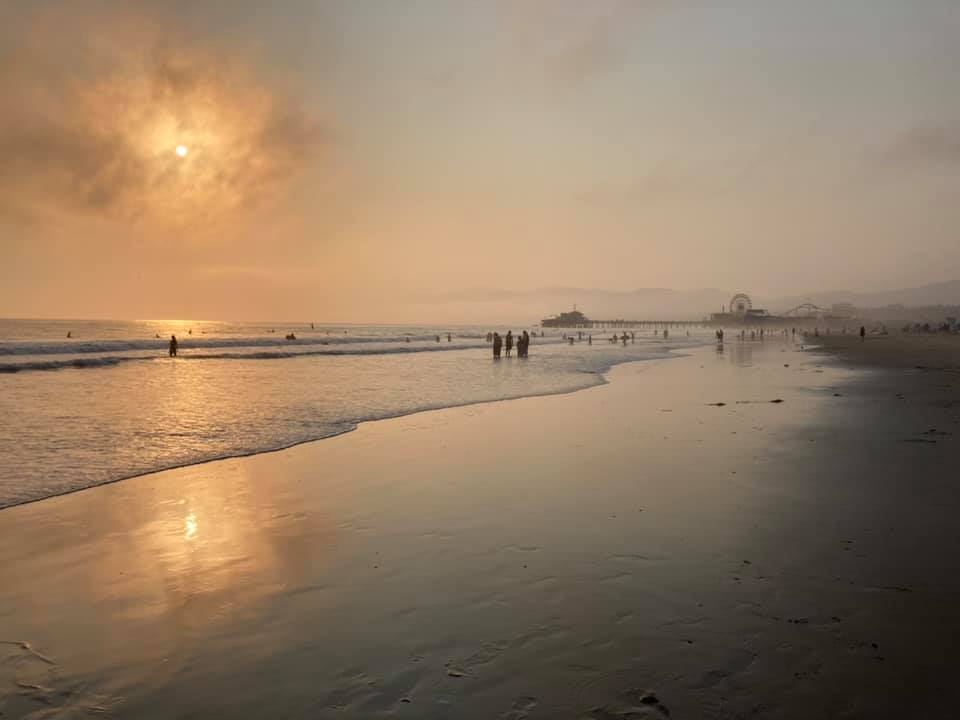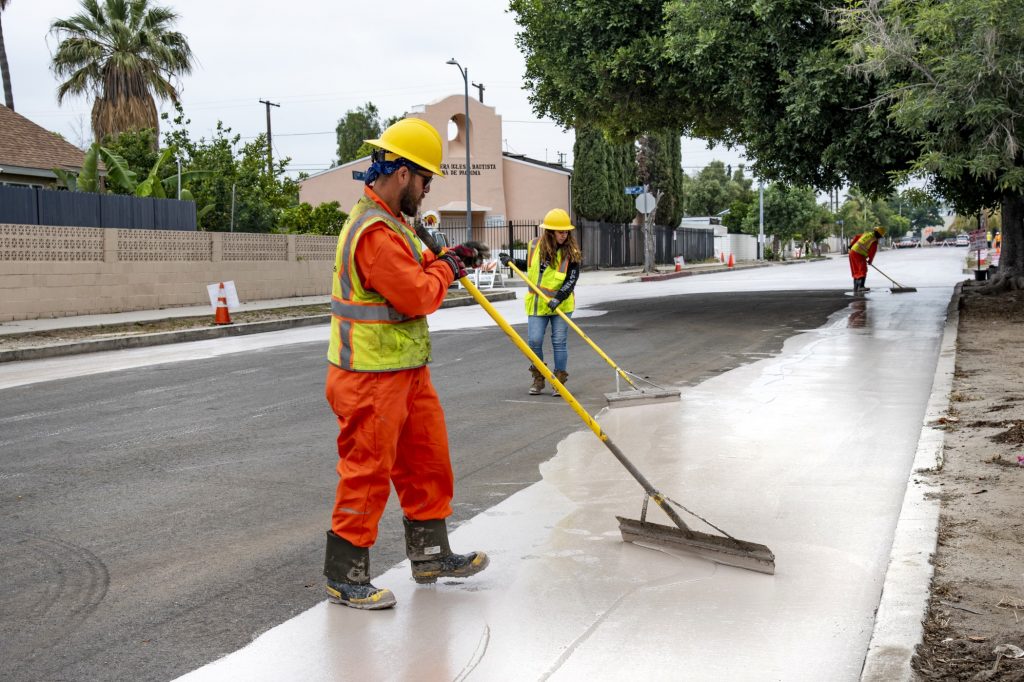Beat the Heat
As Angelenos swelter in historic heatwave, city and county governments seek to cool vulnerable residents

Wildfires sparked by dry lightning storms across California this week are an ominous cap to the state’s historic heat emergency, adding hazardous air quality and evacuation orders to the burdens of the COVID-19 pandemic and economic crisis.
Fire risk aside, the heat wave is now entering its most deadly phase. Nationwide, heat kills more Americans than any other weather-related hazard, with 9,000 heat-related deaths recorded from 1979–2014. As many as 450 Californians may have died in a 2006 heat wave. In Los Angeles, mortality tends to increase roughly fivefold from the first to the fifth consecutive day of a major heat event. We’re now in day eight–with excessive heat warnings extended through tonight.
Meanwhile, the pandemic has cut off malls, movie theaters, public pools, and other neighborhood escapes, except for 17 public cooling centers across the county, leaving Angelenos to rely on personal fans, air conditioning units, and other strategies to beat the heat.
Disproportionate impacts of heatwaves
Global greenhouse gas emissions have already contributed to more than 2°C of temperature increases in many Southern California communities over the last century. As a result, vulnerable populations in Los Angeles, especially the elderly, Black, and Latino residents, now face increased health risks due to longer and hotter heat waves.
A comprehensive account of extreme heat’s damaging effects on Los Angeles can be found in the city’s 2018 Local Hazard Mitigation Plan, a 471-page catalog of vulnerabilities to various disasters (dam failure, cyber-attacks, and pandemics, among others) that ranks “adverse weather” (primarily extreme heat, high winds, and tornadoes) second only to a major earthquake in a list of the city’s most consequential hazards.
The report notes the disproportionate health burdens faced during heatwaves by the elderly, children, low-income residents, and those experiencing homelessness, and describes the grim effects of high temperatures: “heat waves do not strike victims immediately, but rather their cumulative effects slowly take the lives of vulnerable populations.”
At the same time, heat emergencies have minimal impact on buildings—besides the occasional overworked HVAC unit—although heat can strain public infrastructure, like electric grids, railroad tracks, and pavement. The lack of violent fatalities and large-scale property damage associated with heat waves may help explain their relative absence from the popular imagination of Los Angeles’ destruction – a global fascination now kicking into gear as wildfires ignite.
Perceived risk of heatwaves also varies across Los Angeles’s geography of inequality. Yale research found Angelenos in low-income neighborhoods such as South and Central Los Angeles are more likely to anticipate serious potential health risks from heatwaves than residents of the Westside and Beach Cities, who typically enjoy more access to air conditioning, cool ocean breezes, and green space.
Planning for a hotter Los Angeles

So how can Los Angeles cope with its extreme heat?
The City of Los Angeles’s 2019 sustainability plan specifies actions to reduce the absorption of heat in pavement and buildings, which often leads to significantly higher urban temperatures than nearby rural areas. These actions include:
– Requiring cool roofs for all new and refurbished homes by 2020. In 2013, the City of Los Angeles enacted a requirement for new residential buildings and major refurbishments to install cool roofs with reflective surfaces, the first major U.S. city to do so. Emmett Institute research, led by Cara Horowitz, influenced the development of this policy, as did advocacy by groups like Climate Resolve, a local leader in urban cooling. The Los Angeles Department of Water and Power (LADWP) provides cool roof rebates for consumers and commercial customers.
– Piloting 6 “cool neighborhoods” by 2021 and 10 by 2025, with features like water parks, shade, cool transit stops, and neighborhood communications. Last October, the city launched its first “cool neighborhood” in South Los Angeles with a mix of street-level cooling strategies, including cool pavement, transit-stop and sidewalk shade, and water fountains. A pilot project led by Climate Resolve in Canoga Park offers more ideas for neighborhood-scale interventions.
– Installing 250 miles of cool streets by 2028 and updating city regulations to require new buildings use materials on non-roof surfaces that reduce urban heat.
– Adding 90,000 trees by the end of next year, with a goal of increasing the city’s urban tree canopy by 50% by 2028 in communities with the most need. As of August, the city has planted 31,000 new trees; a recent feature in The Atlantic profiles the program and the city’s first-ever forest officer, appointed last summer.
A 2018 City of Los Angeles resiliency plan includes a goal to protect vulnerable populations from heat, via actions similar to those in the sustainability plan, such as increasing tree cover and launching neighborhood pilots. Other actions include:
– Developing a heat vulnerability index and an action plan with recommendations for budget priorities and policies to support resilience to heat.
– Expanding the number of cooling centers accessible by bus and rail, with longer opening hours and access to additional services.
For its part, Los Angeles County included several measures to address urban heat in its first sustainability plan, released last year with input from Emmett Institute and other UCLA faculty members. Specific actions for the next four years include:
– Conducting assessments of both physical infrastructure and social vulnerability to heat. A consultant team chosen by the county started its assessment this summer.
– Developing a strategy to reduce the heat island effect through street-level improvements like cool pavements and tree planting. The county’s public health department completed a draft strategy in 2018, but is anticipating delays to finalizing the report due to COVID-19-related budget shortfalls.
– Building shade at major rail and bus stops, prioritizing places experiencing the worst effects of urban heat. A one-year update from the county this week didn’t report on this action.
Together, measures to promote urban cooling can make a big difference in Los Angeles neighborhoods experiencing excess heat.
The detailed Rx for Hot Cities report, released this year by local nonprofit TreePeople and a group of researchers and urban practitioners called the Los Angeles Urban Cooling Collective, suggests that if Los Angeles implements ambitious measures to increase tree cover and heat-reflective urban infrastructure, “Angelenos could enjoy a climate in the year 2070 that is like the climate in year 2020.”
The Rx report brims with ideas for urban cooling, drawn from Los Angeles and around the world. Its authors share an optimistic viewpoint, describing how the kind of neighborhood-scale interventions currently being implemented across the city can achieve measurable reductions in urban heat, thereby significantly improving health outcomes in vulnerable communities.
“In an era when climate change is widely considered the existential challenge of our time,” the urban cooling experts affirm, “the notion that local, coordinated action can provide protection for communities most at risk strikes us as a worthwhile endeavor.”
Further reading:
Climate Change in the Los Angeles Region (UCLA Center for Climate Science, 2015)
City of Los Angeles 2018 Local Hazard Management Plan (City of Los Angeles, 2018)
Resilient Los Angeles (City of Los Angeles, 2018)
OurCounty: Los Angeles Countywide Sustainability Plan (Los Angeles County, 2019)
L.A.’s Green New Deal: Sustainable City pLAn 2019 (City of Los Angeles, 2019)
Rx for Cool Cities: Climate Resilience Through Urban Greening and Cooling in Los Angeles (TreePeople, 2020)







Reader Comments